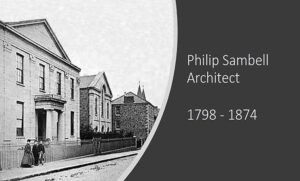
Philip Sambell was undoubtedly an architect of considerable talent as many of his buildings testify. He was all the more remarkable because he had to battle against the twin infirmities of being both deaf and dumb. Cornish historian, Susan Coney brings us his story and details of some of the edifices which still bear his name.
If you walked along River Street in May 1840 to go to the Post Office to buy a newly issued penny black postage stamp, you would have got your feet wet as what is now River Street was then the course of the River Kenwyn.
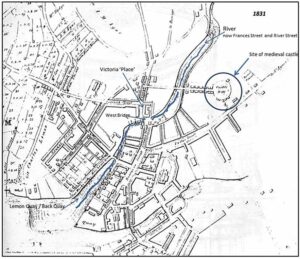 1831 survey map Courtney Library, Royal Cornwall Museum.
1831 survey map Courtney Library, Royal Cornwall Museum.
In May 1835, the Truro Improvements Bill was read in the House of Commons. It included the proposal for a new street linking the area known as Ferris Town to Victoria Place. The new street became River Street.
The river Kenwyn was diverted slightly to the north, then underground so that the old West Bridge was no longer required.
 1842 Symons survey map Courtney Library, Royal Cornwall Museum.
1842 Symons survey map Courtney Library, Royal Cornwall Museum.
In 1845, a new building was to be erected on the new land – The Truro Savings Bank designed by Philip Sambell.
On the 1st November 1845, with much pomp and ceremony, including a parade through the town headed by the town band, the foundation stone was laid by the Earl of Falmouth the then president of the Truro Saving Bank.
The tradesmen chosen to build the new bank were all from Truro:
Messrs. Clemens, Nicholls, Bonds, and Blacker.
For Carpenter’s work, Mr. J. Broad.
For the plastering, Messrs. R. and W. Lidgey.
For painting and glazing, Mr. Solomon.
Statuary, Mr. W. Pearce, Lemon Street.
Iron work, palisades, &c., Messrs. Burnett and Jeffree.
Plumber’s work, Mr John Cock.
The granite for the building came from Mabe.
On Tuesday the 14th September 1847, to mark the completion of the contract work, the Architect (Mr. Sambell), Clerk of Works (Mr. Barry) with the Bondsmen and Tradesmen, in all 22 in number, dined together at The Seven Stars Inn in Boscawen Street.
 The Seven Stars, Boscawen Street (Public Houses and Taverns of Truro by Tony Mansell)
The Seven Stars, Boscawen Street (Public Houses and Taverns of Truro by Tony Mansell)
In 1847, when walking down the new River Street to the post office to buy a newly issued octagonal one shilling green, you would see the magnificent new building ‘with main entrance through a raised portico, with Doric pillars of granite, and pediment above it bearing the inscription Savings Bank instituted 1818’.
In 1894 the Truro Savings Bank closed. This announcement was followed by some speculation as to what uses ‘the substantial bank premises could be put to in the future’.
In 1897, it became Henderson’s Mining School.
In January 1908, the Mining School in River Street, Truro, was offered for sale and was purchased by The Royal Institution of Cornwall for their Museum and Art Gallery. The purchase was championed by Mr George Penrose (Bardic name Gwythyas), who was the RIC Museum curator from 1900 to 1951.
Philip Sambell Architect 1798 – 1874
Philip Sambell was born on the 15th August in 1798 and baptised in Devonport. He was born profoundly deaf and as a consequence, was speechless.
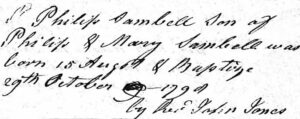
In 1816, his father, Philip Sambell Snr, was declared a bankrupt.
The family moved to Truro in 1822, initially living in Fairmantle Street.
In 1834, Philip Sambell Snr was bankrupt again.
Bodmin Gaol Record:
Name: Philip Sambell.
Age: 62.
Marital Status: Married.
Occupation: Timber merchant.
Birth Year: about 1774.
Abode or Birth Place: Devonport late Truro.
Discharged Date: 1836 Prison.
Notes: Not answering satisfactorily, the Commissioners of Bankrupts’ questions. Previously a debtor. Adm. 16 April 1834, examined at the Summary Sessions.
Re-examined 7 July 1834, in Truro, and recommitted 9th July.
Finally discharged by the Commissioners 5th Oct. 1836.
Pockmarked, has a Jewish appearance.
Registration Number: 4790.
By this time his son, Philip Sambell, was firmly established as a well-respected architect.
In 1841, the Sambell family lived in Trafalgar Row (Malpas Road), Truro.
By 1851, Philip Sambell Jnr had moved to Falmouth (Winchester Buildings which were near the Royal Yacht Club) with his spinster sister Eliza and Leticia, his niece.
In 1871, all three had moved to Dunstanville Terrace, Falmouth, near the Greenbank Hotel and overlooking the Royal Yacht Club. Note that it records that Philip was ‘deaf and dumb’.
 Philip died in Stonehouse Plymouth on the 5th December 1874
Philip died in Stonehouse Plymouth on the 5th December 1874
The death announcement appeared in the West Briton and Cornwall Advertiser of the 10th December 1874:
He was buried on the 12th December 1874 at Ford Park Cemetery, Plymouth.
Philip Sambell – the Architect who designed many Cornish buildings
St John’s Church, Lemon Street, Truro
A new chapel in Lemon Street, Truro (St John’s Church) was built on freehold land given by Sir Charles Lemon.
The foundation stone was laid by Thomas Daniell in 1827 and the church was built in 1828 to the designs of the architect Philip Sambell of Devonport.
It was modified in 1860 by William Henry Reid of Plymouth and extensive alterations were carried out by James Arthur Reeve of Exeter in 1884. The ceiling of carved wood replaced the plaster ceiling. A new organ was introduced. Stained glass windows by Heaton, Butler and Bayne were inserted.
The church reopened on 12 October 1884.
There were further changes in 1892.
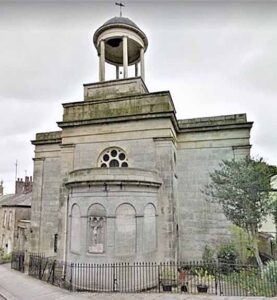 St John’s Church ‘today’. The basic building was designed by Philip Sambell.
St John’s Church ‘today’. The basic building was designed by Philip Sambell.
St Mary’s Wesleyan Chapel, Union Place, Truro, which opened in 1830
In 1826, an advertisement appeared for tradesman to build a ‘New District Chapel, St Mary’s Chapel (St Mary’s Methodist Church)’.
The Architect was Philip Sambell of Lemon Street.
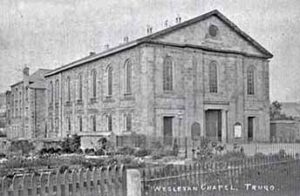
Lander’s Monument Column – Philip Sambell’s design chosen in 1834

Strangways Terrace and Strangways Villas
Strangways Terrace and Strangways Villas 1835 – the architect Mr P Sambell drew up a plan for buildings on the site of the barracks, which were to the left of the top of what is now Lemon Street, which Sir Charles Lemon adopted. (Truro Buildings Research Group 1985).
 Strangways Terrace.
Strangways Terrace.
Castle Street, St George’s Road and River Street
‘He (Philip Sambell) drew up plans for Castle Street, St George’s Road and River Street (Truro)’. Quote from Truro Buildings Research Group 1985).
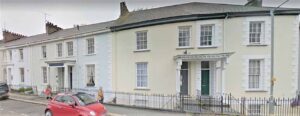 St Georges Road, Truro.
St Georges Road, Truro.
Philip Sambell’s new Office in Truro
 23, Frances Street, Truro.
23, Frances Street, Truro.
Large Houses off Edwards Street and Castle Street
It is understood that Philip Sambell designed the large houses off Edwards Street and Castle Street facing the Leats, Truro. (From Philip Sambell Jr., An Architect of his time by Frank Sambell).
Walsingham Place
Quote from Truro Buildings Research Group 1985: ‘I cannot find definite evidence that he (Philip Sambell) was the architect responsible for the design of Walsingham Place (1837) but it would seem very probable’.
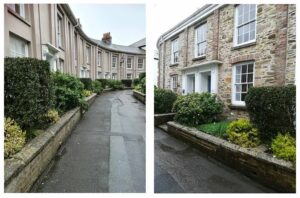 Walsingham Place.
Walsingham Place.
Baptist Chapel, Clarence Street, Penzance 1835/1836 – Architect Philip Sambell
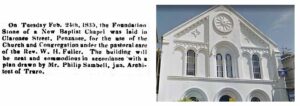 Baptist Chapel Penzance.
Baptist Chapel Penzance.
St Clement’s Chapel of Ease
The Truro Buildings Research Group 1985 stated that St Clement’s Chapel of Ease (St Paul’s Church) Truro, ‘was built to his [Philip Sambell] design’. However, it is incorrect – the architect was Scott and Moffett, not Philip Sambell.

Truro Savings Bank – foundation stone laid in 1845 – Architect Philip Sambell
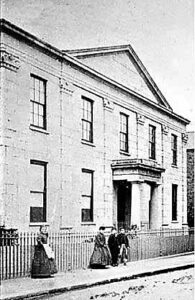 Photograph from the Royal Institution of Cornwall photographic collection at the Royal Cornwall Museum.
Photograph from the Royal Institution of Cornwall photographic collection at the Royal Cornwall Museum.
Baptist Chapels in Helston and Redruth 1846 (Truro Buildings Research Group 1985)
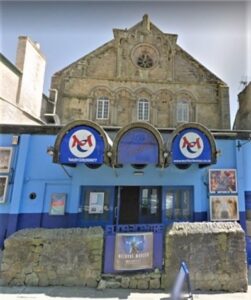 Baptist Chapel Wendron Street Helston (now the Flora Cinema)
Baptist Chapel Wendron Street Helston (now the Flora Cinema)
Baptist Chapel, Truro, opened in 1850
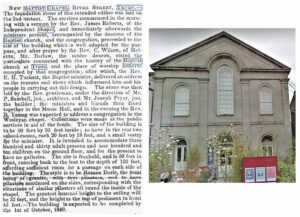 Baptist Chapel, River Street, Truro – foundation stone laid Nov 1848. Architect Philip Sambell (Deacon of the Chapel).
Baptist Chapel, River Street, Truro – foundation stone laid Nov 1848. Architect Philip Sambell (Deacon of the Chapel).
Town Hall, Truro
It is understood that in 1848 Philip Sambell submitted plans for the new Town Hall Truro which were not adopted. (From Philip Sambell Jr., An Architect of his time by Frank Sambells).
Post Office, Falmouth
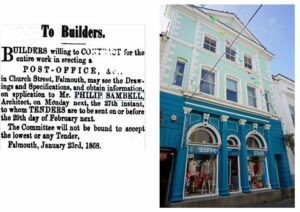
The old Post Office Falmouth, ‘today’.
Home for destitute female children, Falmouth
In 1871, a new building for destitute female children was built at the west end of Bellevue Terrace (now part of Trevethan Road), Falmouth.

Many of Philip Sambell’s architectural plans were donated to the Royal Cornwall Institution but unfortunately, they cannot be found.
Some of Philip’s Lectures and Letters
Philip Sambell wrote many beautifully illustrated essays which were delivered as lectures by others on his behalf. Copies of these were published in the Journals of the Royal Institution of Cornwall and are held in the Courtney Library at the Royal Cornwall Museum in River Street, Truro.
These are a small selection of his lectures:
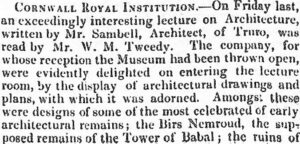 This essay in which Philip Sambell attempts to trace the origin and progress of Architecture including the ancient arts of India, Egypt, Greece and Italy, was delivered by the secretary of the Royal Institution of Cornwall on the 8th November 1839.
This essay in which Philip Sambell attempts to trace the origin and progress of Architecture including the ancient arts of India, Egypt, Greece and Italy, was delivered by the secretary of the Royal Institution of Cornwall on the 8th November 1839.
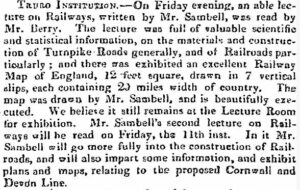
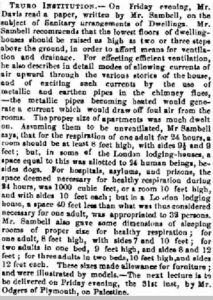 Paper on the sanitary arrangements of dwellings 1848.
Paper on the sanitary arrangements of dwellings 1848.
 Paper entitled – ‘simple explanation of the principles of the Atmospheric system of railway propulsion’.
Paper entitled – ‘simple explanation of the principles of the Atmospheric system of railway propulsion’.
He also wrote letters for magazines such as the Architect. This one is dated 1835.


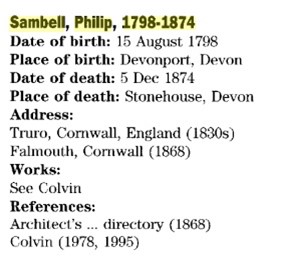 Philip Sambell’s entry in the directory of Architects.
Philip Sambell’s entry in the directory of Architects.
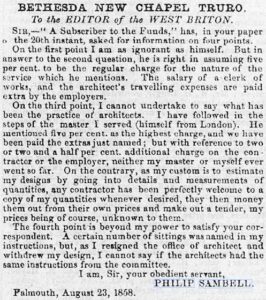
Philip lived with his sister, Eliza, all of his life and maybe it was she who taught the young Philip to read and write.
Philip Sambell’s Headstone Inscription in Ford Park Cemetery, Plymouth:
IN LOVING REMEMBRANCE OF PHILIP SAMBELL WHO DIED DECEMBER 5, 1874
HE WALKED WITH GOD THROUGH GREAT AFFECTION AND HAD ON CEASING** FAITH IN JESUS WHO HATH SAID ‘I AM THE RESURRECTION AND THE LIFE. HE THAT HATH BELIEVETH SHALL HE LIVE’
JOHN II 25
**The headstone actually states “ON CEASING” but we are left to wonder if the intention was to state “UN CEASING”.
Several other members of his family are also named on the headstone including Eliza (his sister) and Leticia (his niece).
This is by no means a comprehensive account of Philip Sambell’s life and achievements. More information can be found in Frank Sambells Book Philip Sambell Jr, An architect of his time 1789-1874.
 Susan Alecia Coney (née Phillips)
Susan Alecia Coney (née Phillips)
Although I was never very interested in history at school, it is now a big part of my life. I enjoy both the research and writing about it. Initially, it was about my family and their involvement in the community but this sparked a more general interest in Cornish history, of its people and places. I have been involved in a number of projects relating to Truro and have enjoyed this opportunity to record the results for future generations.
